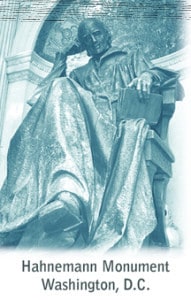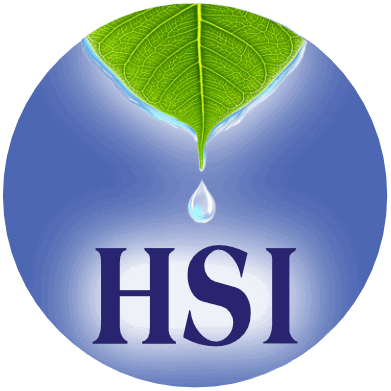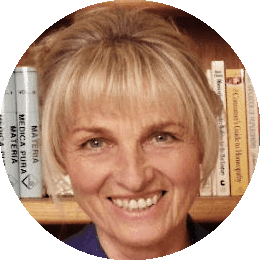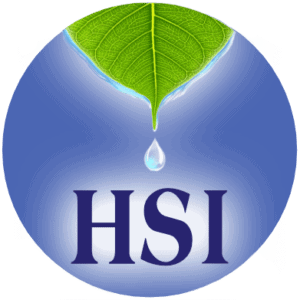Samuel Hahnemann (1755-1843)
“Non inutilis vixi”
Sheila Gray
Sheila is a British homeopath with a background in nursing, a degree in English Literature and Sociology from the Glasgow University; diplomas in several massage modalities and aromatherapy. She may be reached at Holistic Transformations
 So close to midnight, that there is debate as to the date, Christian Friedrich Samuel Hahnemann was born, in the town of Meissen, Saxony. The church register recorded his birth as being on the 11th April 1755, but Samuel always celebrated his birthday on the 10th. As the story of his life unfolds, this is a pertinent fact to bear in mind, because arguably, it sets a pattern that continued throughout.
So close to midnight, that there is debate as to the date, Christian Friedrich Samuel Hahnemann was born, in the town of Meissen, Saxony. The church register recorded his birth as being on the 11th April 1755, but Samuel always celebrated his birthday on the 10th. As the story of his life unfolds, this is a pertinent fact to bear in mind, because arguably, it sets a pattern that continued throughout.
He was a delicate baby, so much so that he was christened only a few days later, on the 13th, when it is highly unlikely that anyone thought he would live to be a skilled linguist, chemist, doctor, and the founding father of a new system of healing known as homeopathy. Happily, he survived to live a full life, in fascinating times.
Samuel was born in the midst of the Enlightenment, or Age of Reason, a time of free thinking and scientific rational thought. He lived into the Romantic Movement and Counter Enlightenment. A glance at the history of the period is like reading a who’s who of philosophy, science, literature and music. Kant, Goethe, Hegel, Voltaire, Rousseau, Paine, to name but a few. It was a period of exploration, discovery and rapid change with the Industrial Revolution, but also a time of conflict and war with The American Revolution, The French Revolution, and The Napoleonic Wars, to name but a few.
The year after Samuel’s birth, the Seven Year War (1756-1763) broke out. Frederick the second of Prussia was fighting Austria for Silesia. This war adversely affected the people of Saxony, especially so when Frederick used the porcelain and cloth that the area was famous for, to fund his campaign. It took the porcelain workers several years to recover, and since Samuel’s father, Christian, was a porcelain painter, the family fortune suffered.
Because of this, Samuel’s early years of schooling were undertaken by his parents at home. The workers at the factory where his father worked told a visiting professor to the town, that Christian sometimes locked his son up with a problem when he went to work, expecting him to have solved it, or to have some insight into it, by the time he got back. Perhaps this unorthodox method of teaching bore fruit in later years when Samuel was working out how to improve the lot of suffering humanity.
Later, he went to the Town Elementary School in Meissen, where one of the teacher’s, Magister Johann Muller, was particularly impressed with his abilities. When he was almost fifteen, however, his father, a strict man of the Lutheran faith, and with a strong work ethic, took him out of school, having found employment for him in a grocery store in Leipzig. Samuel absconded and his mother had to hide him until she could be sure his father would welcome him. Possibly this is an indication that Samuel already knew himself well enough to know that this was not his path, and had the courage to do what had to be done, even if it risked the wrath of a powerful authority.
This incident coincided with Magister Muller becoming rector of the Prince’s Grammar School in Meissen which Samuel then attended, studying languages, mathematics, geometry and botany. In spring 1775, Samuel wrote his school dissertation, “The Wonderful Construction of the Human Hand”, and delivered it on Speech Day, a fitting topic for one about to embark on a medical career.
Shortly afterwards he returned to Leipzig, this time to study medicine. He paid for his studies by teaching German and French, and by translating Greek and English into German for better-off students. Help came from an anonymous benefactor in Meissen who paid for some of the lectures. It is in Leipzig, that the seeds of Samuel’s discontent with the medical profession of the time were sown, because he was not satisfied with some of the lectures, and attended them only selectively. He was also unhappy with the lack of practical facilities.
Late in 1777 he moved to Vienna to benefit from practical experience working under a Dr. Quarin, in the hospital of the Brothers of Mercy. Even though Dr. Quarin did not charge Samuel a fee, the financial situation became critical, maybe because the invaluable hands-on experience allowed less time for translation work. Help was once again at hand, this time when Dr. Quarin, introduced him to the Governor of Transylvania, Baron von Brukenthal who offered him a post as librarian and family physician.
Samuel stayed in Hermannstadt for a year and nine months, cataloguing books and manuscripts – including medical and alchemical works detailing substance preparation and purification in various languages – and gaining medical experience. The baron also introduced him to the Masonic Lodge. The young Hahnemann must have gained much knowledge, both scientific and esoteric/metaphysical, at this time that he would draw on in years to come.
He still had to finish his formal education, however, and left for the University of Erlangen where he obtained his Doctor of Medicine degree, specializing in botany, on 10th August, 1779.
Hahnemann’s first practice was in the copper mining area of Heddstedt in 1780. He did not stay long, and moved to Dessau the following year, where he met his wife Johanna, the daughter and step-daughter of apothecaries. She was a strong woman, and a staunch and supportive wife, even sacrificing her inheritance and selling her jewellery to keep them during his wilderness wanderings, where he made around twenty moves in as many years.
The reason for this was his disillusionment with the medicine of the times. Like the rest of the world, it was changing. The old ways were breaking down, and he felt that many doctors followed the proliferation of new ideas and treatments unthinkingly, also that many of the treatments, such as bloodletting, and the use of toxic substances in crude doses were cruel and abusive and did more harm than good. He was also critical of the attitudes adopted, especially towards mentally ill patients, and of the hygiene practices of the doctors and nurses.
It is impossible to present a true portrait of Hahnemann without mentioning that he spoke out against these practices with a sense of outraged indignation, and was, arguably, his own worst enemy with his criticisms of his peers, especially Broussais, and his followers: “… they killed gradually more millions than Napoleon ever slew violently in battle.” (The Organon, Paragraph 60. Footnote.) He suffered greatly for this, and experienced many trials and tribulations, and much hardship.
For a time he gave up practicing altogether, and earned a meager living as a translator of medical books and journals, which at least had the advantage of keeping him abreast of the latest developments. He also became a prolific writer of articles and books.
As well as this, he was continually studying and experimenting, looking for a gentler, more humane way of treating the sick. A pivotal point came when, in 1790, he translated A Treatise on Materia Medica by the Edinburgh doctor, William Cullen who stated that Cinchona Bark (Cortex peruvianus) cured malaria because of its tonic effect on the stomach. Hahnemann believed that it cured malaria because it was capable of producing similar symptoms in healthy people.
This led him to study poisonings, and to experiment with the Peruvian bark on himself, by taking it twice daily and recording the symptoms he experienced. They were all those usually associated with intermittent fever. This was the first “proving” – the name given to the systematic process of ascertaining the range of action of a homeopathic medicine.
Another important development came in 1796 when his “Essay on a New Principle for Ascertaining the Curative Power of Drugs and Some Examinations of Previous Principles,” was published in Hufeland’s Journal of Practical Medicine. For the first time, Similia similibus, is mentioned – like with like – to cure a disease, medicines that cause similar symptoms in the healthy human body must be used.
It is in another article in Hufeland’s Journal, in 1807, “Indications of the Homeopathic Employment of Medicines in Ordinary Practice,” that he first uses the word derived from the Greek homoios –similar, pathos – disease or suffering.
But it is in The Organon that the principles of his new system of healing are fully expounded. It was published in five editions over Hahnemann’s lifetime, and is really a portrait of a work in progress, based on clinical experience. The first edition was published in 1810, and was called The Organon of the Rational Art of Healing. Thereafter, it was called The Organon of the Healing Art. Hahnemann completed a sixth edition before he died, but it was not published until 1922. If a life is a soul’s work in progress, then the sixth edition is the finished vision.
The Organon is laid out in numbered sections called paragraphs that are referred to below. Italics are used where they are used in The Organon. The capitals are mine. The following are lesser, but nonetheless, important topics or themes addressed in the text:
- Paragraphs 1 and 2 demonstrate his Hippocratic ideals, by stating the AIMS and OBJECTIVES of the physician. “The physician’s highest calling, his only calling, is to make sick people healthy – to heal, as it is termed…. The highest ideal of therapy is to restore health rapidly, gently, permanently; to remove and destroy the whole disease in the shortest, surest, least harmful way, according to clearly comprehensible principles.”
- The need for “pure experiment” (Paragraph 25) and adherence to SCIENTIFIC METHODS and PRINCIPLES.
- The importance of PUBLIC HEALTH measures (Paragraph 77) such as good living conditions and healthy lifestyle on the part of the patients, and on clean, hygienic practices by the doctors and nurses.
- The importance of proper NUTRITION. (Paragraphs 125, 260, 262, 263, 266 especially) He published a two volume tome “The Friend of Health,” in 1792 and 1795, based on the principles of hygiene and dietary measures.
- The PERSONAL DEVELOPMENT of the physician, who is exhorted to “KNOW THYSELF” (Paragraph 141) and to engage in REFLECTIVE PRACTICE. (Paragraph 61)
- CASE-TAKING and COMMUNICATION SKILLS in which the physician adopts the role of “UNPREJUDICED OBSERVER,” (Paragraph 6), who takes each case in accordance with the guidelines given in Paragraphs 83 – 99. These instructions include:
- A PATIENT CENTRED APPROACH. The physician is to rely on his own observational skills, and also to glean what he can from relatives and friends, but must listen especially carefully to the words of the patient (Paragraph 98)
- The HUMANE TREATMENT of the INSANE. Paragraphs 210 – 230.
- The importance of CORRECT PREPARATION of MEDICINES. (Paragraphs 245 – 285) He wrote a four volume Pharmaceutical Lexicon. (1796).
- The MIND-BODY LINK. (Paragraph 210.) “The so-called emotional and mental diseases…do not constitute a class of diseases completely separate from all others, because in so-called physical diseases the emotional and mental state is always affected.”
All of these concepts are part and parcel of the training of today’s health care professionals, but in Hahnemann’s day, they were revolutionary. Of course, he was not the only one seeking to take the human race to higher heights. For example, Pinel (1745 – 1826) in France was also seeking to improve the treatment of the insane, Jenner (1749 -1823) was a contemporary, and Pasteur (1822 – 1895), Lister (1827 – 1912), and Florence Nightingale (1820 – 1910) were soon to follow.
A study of his life shows how the seeds sown in the minds of more enlightened, caring, compassionate people in tune with the spirit of the times, took root and grew. They demonstrate how he, and others, worked from the heart, but harnessed the mind to tap into the unfolding Divine idea.
There is also much in The Organon about the treatment of ACUTE AND CHRONIC DISEASES, EPIDEMICS and FEVERS, and about the SUPPRESSION of SYMPTOMS, PREDISPOSITION, SUSCEPTIBILITY and MIASMATIC factors. Hahnemann believed that the psora (skin, scabies, underfunction) was the most important weakness, but also mentioned the sycotic miasm (gonorrhoea, overfunction), and the syphilitic miasm (distorted function). Of course, AAB and DK have much more to say about this and other topics mentioned by Hahnemann in Esoteric Healing.
All of the above concepts are very much part of his homeopathic theory of disease and its treatment, but the crux of his work is that he believed there was a SPIRIT-LIKE DYNAMIS, a VITAL FORCE or PRINCIPLE that was the essence of man:
“In the state of health the spirit-like vital force (dynamis) animating the material human organism reigns in supreme sovereignty. It maintains the sensations and activities of all the parts of the living organism in a harmony that obliges wonderment. The reasoning spirit who inhabits the organism can thus freely use this healthy living instrument to reach the lofty goal of human existence.” (Paragraph 9)
He also says: “Without the vital force the material organism is unable to feel, or act, or maintain itself. Only because of the immaterial being (vital principle, vital force) that animates it in health and in disease can it feel and maintain its vital function. Without the vital force the body dies; and then, delivered exclusively to the forces of the outer material world, it decomposes, reverting to its chemical constituents.” (Paragraph 10).
He also believed that: “It is only the pathologically untuned vital force that causes diseases.” (Paragraph 12) This energetic untuning and the consequent disharmony that manifested as disease on the mental, emotional and physical planes, was often the result of a trigger factor that he termed the exciting cause (Paragraph 5), resulting not just in one single symptom, but in a total symptom picture, or TOTALITY OF SYMPTOMS that was “the outer image expressing the inner essence of the disease, ie. of the disturbed vital force.” (Paragraph 7) He maintained that if the exciting cause, or the sustaining or maintaining cause, could be removed or dealt with, that the vital principle could regain its equilibrium.
Where medicine was needed, however, he postulates that: “In the living organism a weaker dynamic affection is permanently extinguished by a stronger one, which, though different in nature, nevertheless greatly resembles it in expression.” (Paragraph 26)
So here we have the concepts of dynamics – energy, and of resembles – similars.
First of all, resemblances, the Law of Similars, or like cures like. Hahnemann believed that only a substance that caused a symptom, or pattern of symptoms in a healthy person, could cure those same symptoms in a sick one.
Secondly, dynamics. Hahnemann believed that the medicine had to be dynamised, or potentised before it could affect the spirit-like vital force. In Paragraph 269 he says: “Similarly, by the trituration of a medicinal substance and the succussion of its solution (dynamisation, potentization) the medicinal forces lying hidden in it are developed and uncovered more and more, and the material is itself spiritualized, if one may use that expression.”
So when a medicine that matched the totality of symptoms was energized to a high enough potency, it would heal the disease.
In the final paragraphs of the Organon (286 – 291) Hahnemann finishes with a more general discussion of energy. He mentions mineral magnetism, electricity and galvanism, but that too little was known about them. Mesmerism was another controversial method of treatment at that time. Hahnemann seemed to be against the more extreme forms of it, but he could see that there was something in it, because it did help some people, and he even seemed to have quite an understanding of how it worked. He also saw the energetic value in massage therapy.
However controversial he may have been, Hahnemann was a pioneering thinker, and a server of humanity. He felt for the suffering people with his heart, and was willing to deprive himself of the comfortable life he could have had, in order to use his mind to think of a more humane way of helping them.
To do so, he drew on a wide variety of sources. He believed in deism, popular at the time, and was influenced by vitalism and other old ideas that were recirculating. It is to the ancients in general, and Paracelsus in particular, that the idea of similars must be credited. The principle of the vital force is similar to the Indian prana, or the Chinese chi. Hahnemann provided the synthesis, drawing them all together in his system of homeopathic medicine.
In his later years, he did reap the rewards of his extensive labours. He taught homeopathy at Leipzig University. To do so he had to present a paper, which he did to an auditorium packed with friends and foes, on the historical medical use of White Hellebore (Veratrum album) and Black Hellebore (Helleborus niger). He impressed them with his linguistic and scholastic abilities by quoting from publications in eight languages.
Unfortunately his rants against orthodoxy meant that attendance at his lectures dwindled, but he did have a big enough following to take the beloved homeopathy that he considered a divine gift from the Creator, all over the world. He also had enough support from a number of young doctors, to form a proving group which greatly accelerated the work of proving, or determining the therapeutic value of the remedies. The results of these he published in six parts in his Materia Medica Pura between 1812 and 1821.
Once again though, he was forced to move because of a court action lodged by some physicians and apothecaries, which was upheld and made it almost impossible for him to practice. The Duke of Anhalt-Kothen, however, came to his rescue, and allowed him to work in his little principality.
Johanna died in Kothen. That, and the tragedies that befell so many of their eleven children – including two of their daughters being murdered – were blows to Hahnemann. Despite the public conflicts, his personal life was relatively harmonious. He found solace in his family.
In typical Hahnemannian, unorthodox and controversial fashion he remarried. His new wife was the young Parisian artist, Melanie d’Hervilly. They moved to Paris and enjoyed a thriving practice. Once again there was controversy. Melanie got into trouble for practicing medicine without a license.
Yet she assisted him in his service to humanity. They treated everyone from very rich to very poor. As always, Hahnemann only charged if he helped people, or made a significant difference, and had a sliding scale of fees from rich to poor, once again showing the egalitarianism of this man, who considered the lowliest of men his brother.
Samuel Hahnemann was a microcosm of the macrocosm, in that his life was very much a reflection of the spirit of the times. He was a combination of scientific rationalism in the precise, methodical way he carried out the provings and insisted on precision in the pharmaceutical process, but there was an element of mystical romanticism in his high ideals and belief in the spirit-like vital force.
Just as he was born, almost on the cusp of midnight, with his life in the balance, so there has always been a fine balancing of pairs of opposites in his life: violent opposition – true disciples; rational science – romantic idealism; public controversy – personal harmony; need for change – resistance to change; yet remaining ever focused toward the goal.
Another trend in his life was that of deferred gratification. The value of his work did not receive immediate recognition. It was the same in death. Melanie did not allow visitors to his sickbed. Nor did she announce his passing or the time of his funeral. He died in the early hours of 2nd July 1843. His funeral, in the pouring rain, was attended by only a handful of people. It was not until 1898 that he was reinterred with full civic honours. Inscribed on his tombstone, at his request, are the words “non inutilis vixi” – I have not lived in vain.
Hahnemann’s work fit into the unfoldment of the Plan, and added to the development of human consciousness, because it began to explain the link between energy and disease. He was ahead of his time, a forerunner.
At the beginning of the twentieth century the theosophists helped this understanding by bringing the chakra system to the west. Since then there have been remarkable developments in scientific knowledge of the glandular system linked to these energy centres, as well as in-depth explanation of cellular metabolism. Understanding of the Chinese system of medicine has also helped, as has research into the nature of energy in the field of quantum physics and work on the properties of water. Once again, many of these concepts are expounded by AAB and DK.
As yet, similar to the way in which Hahnemann’s work was received at the time, there is not broad acceptance from the mainstream. The controversy continues. Yet homeopathy survives, even thrives, and evolves. Perhaps this century will bring further revelation, allowing it to come of age, and to earn the place that Hahnemann so passionately believed it deserved – as medicine for the new man.
References:
Bailey, Alice, A. Esoteric Healing. Lucis Press, 1953. ISBN: 0-85330-121-1.
Braden, Gregg. The Divine Matrix. Hay House, 2007. ISBN: 978-1-4019-0573-6.
Cook, Trevor. Samuel Hahnemann – His Life and Times. 3rd Edition, 2008. (1st Edition, 1981) .B. Jain Publishers, Ltd. New Delhi. ISBN: 978-81-319-0619-4
Emoto, Masaru. Messages from Water and the Universe. Hay House, 2010. ISBN: 978-1-4019-2746-2.
Hahnemann, Samuel. Organon of Medicine. 6th Edition. (1842) A new translation by Jost Kunzli M.D., Alain Naude and Peter Pendleton. London, Victor Gollancz Ltd., 1991. Translation copyright, 1982 by The Hahnemann Foundation. ISBN: 0-575-03880-2.
Handley, Rima. A Homeopathic Love Story – The Story of Samuel and Melanie Hahnemann. 1990. North Atlantic Books, Berkeley, California. ISBN: 1-55643-049-3.
Milgrom, Lionel. May the (vital) force be with you! – Homeopathy, Star Wars, and the rise of ‘fantasy physics.’ Homeopathy in Practice, Spring, 2010. Alliance of Registered Homeopaths.
Morrell, Peter. Hahnemann Homeopathy from Romanticism to Post-Modernism. Homeopathy International, Winter 2002. Homeopathic Medical Association.
Partington, Theresa. Madness, mesmerism and moral treatments, or, to what extent did the Organon reflect contemporary attitudes to the mentally ill? Homeopathy in Practice, Spring 2010. Alliance of Registered Homeopaths.
Whitney, Jerome. The Evolution of the Organon. Homeopathy in Practice, Spring 2010. Alliance of Registered Homeopaths.


